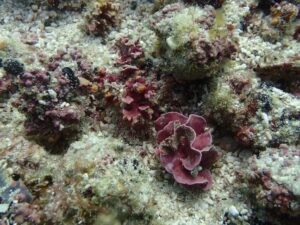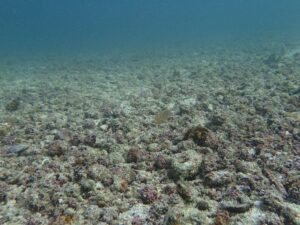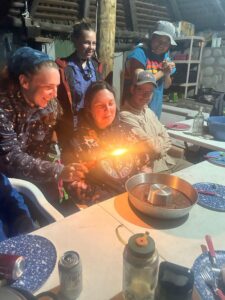By Haylee Bregoff, MLML Invertebrate Ecology Lab
 I had never heard of rhodoliths before our Baja Course (MS273 Marine Environmental Studies of the Gulf of California), but by the time we left El Pardito those little pink calcified wonders had left me absolutely awestruck; rhodolith beds truly are a special place. So what are rhodoliths? Rhodoliths are macroalgal ecosystem engineers that support high levels of marine biodiversity. These small calcified coralline algae are unattached (i.e., free-living) and non-geniculate (i.e., non-jointed, unlike some forms of branching coralline algae). Rhodoliths can cluster together to form beds, or individual nodules can fuse together to form larger conglomerates. Since rhodoliths have a complex branching thalli structure, they provide habitat to a diverse and unique array of associated species; they’re like small, calcified tumbleweeds rolling through soft, sandy bottoms and collecting organisms as they grow. On top of being an important biogenic habitat, rhodoliths provide ecosystem services like water filtration, maintenance of marine pH levels, climate regulation processes, and production of dissolved organic carbon and calcium carbonate.
I had never heard of rhodoliths before our Baja Course (MS273 Marine Environmental Studies of the Gulf of California), but by the time we left El Pardito those little pink calcified wonders had left me absolutely awestruck; rhodolith beds truly are a special place. So what are rhodoliths? Rhodoliths are macroalgal ecosystem engineers that support high levels of marine biodiversity. These small calcified coralline algae are unattached (i.e., free-living) and non-geniculate (i.e., non-jointed, unlike some forms of branching coralline algae). Rhodoliths can cluster together to form beds, or individual nodules can fuse together to form larger conglomerates. Since rhodoliths have a complex branching thalli structure, they provide habitat to a diverse and unique array of associated species; they’re like small, calcified tumbleweeds rolling through soft, sandy bottoms and collecting organisms as they grow. On top of being an important biogenic habitat, rhodoliths provide ecosystem services like water filtration, maintenance of marine pH levels, climate regulation processes, and production of dissolved organic carbon and calcium carbonate.

For eleven days, we called the tiny island known as El Pardito home. Found in the Gulf of California and located about 90 km North of La Paz, the island was vibrant. Brightly painted palapas accented the clear teal water that filled the horizon. Even though we were as close to paradise as I’d ever experienced, it wasn't always easy. Days in the field were long and tiring as we woke up around 5-6 AM every day to check weather reports so we could plan our schedules accordingly. Most mornings I needed to take a second to adapt my plan and go with the flow, which is easier said than done when it comes to collecting data on a time crunch. We were living on island time; the ocean dictated our schedules so all we could rely on was each other.
On the island, we quickly started to grow into a functional and supportive family. After spending three days trapped in cars, you would've thought that we had enough of each other, and if anything, resembled a dysfunctional family. But we were building a community, working together to achieve this unified goal of traveling and experiential learning. We woke up together, we ate breakfast together, we worked in the “lab” together, and together we were able to make these strong new connections to one another. Although at times we were fighting elements like high winds, heat, and swarms of bugs, Isla El  Pardito was a refuge for us Moss Landing students; we supported one another despite our
Pardito was a refuge for us Moss Landing students; we supported one another despite our

cohort year, thesis research, or lab affiliation. Our ability to accomplish so much in such a short period of time taught me the importance of community building and collaboration.
The unifying structure of rhodoliths taught me more about community than I could have ever imagined. Although rhodolith morphology is diverse, with structures being uniquely characteristic and highly differentiated, they still roll on together. They create a habitat brimming with opportunity for life to settle and form communities in unexpected places. Beds with higher rhodolith species diversity and greater abundance are able to support more biodiverse and unique infaunal associations. Our class was like a beautiful rhodolith bed filled with unique individuals, each with our own strengths and interests. Each person with a beautifully distinct “structure” that complimented each other, allowing us to create some amazing memories together. The highlight of my Baja experience was being surrounded by passionate individuals that supported not only my growth as a researcher, but my growth as a person.

